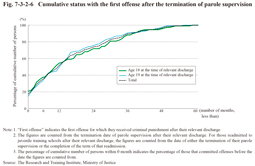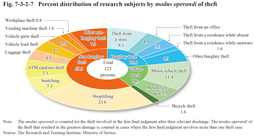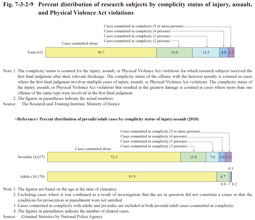2 Situation with offenses
This subsection analyses the offenses committed by the research subjects based on the judgments they received.
(1) Time of the first offense
Fig. 7-3-2-5 shows the number of research subjects that received criminal punishment by age at the time of their first offense, age at the time of their relevant discharge with or without readmission (36 were readmitted and 212 not readmitted), while Fig. 7-3-2-6 shows the period between the date of the termination of their parole supervision (for those readmitted to juvenile training schools, the date of the termination of their parole supervision or completion of the term of that readmission) and the date of their first offense (percentage of the cumulative number of research subjects that committed their first offense in less than the number of months on the horizontal axis of the figure) by age at the time of their relevant discharge.
Fig. 7-3-2-5 Number of research subjects by age at the time of the first offense
Fig. 7-3-2-6 Cumulative status with the first offense after the termination of parole supervision
The distribution of age at the time of the first offense peaked from the first half of age of 20 to that of 21. This trend is more distinct with those aged 19 at the time of the relevant discharge. By six month period the largest number of them committed offenses that resulted in criminal punishment within the first six months after reaching age 20. Similar to those aged 19 at the time of their relevant discharge, many of those aged 18 at the time of their relevant discharge committed the first offense by the first half of age 21. Their age distribution was more dispersed when compared to those aged 19. Taking into consideration Fig. 7-3-2-6, this probably reflects the fact that they were subjected to the research for a longer period of time.
Persons discharged from juvenile training schools on parole are placed under parole supervision, which terminates when they reach age 20, in principle, and receive guidance/supervision from probation officers and volunteer probation officers during their period of parole supervision. This is considered to be a preventive factor with offenses. Almost the same trend in the cumulative status between the date of the termination of parole supervision and the date of the first offense was observed with both those aged 18 and 19 at the time of their relevant discharge, and with more than 50% of them committing their first offense within a year after termination of their guidance/supervision through parole supervision, etc. and approximately 80% within approximately 30 months. Taking this into consideration, offenses that would result in the first criminal punishment are most likely to be committed before reaching age 22.5.
(2) Details of offenses
Next, we analyze the characteristics of the offenses the research subjects committed. The major offenses involved in all criminal punishment, namely theft, injury, etc., Road Traffic Act violations, and negligence in vehicle driving causing death or injury, etc. (See Table 7-3-2-3), are subjected to the analysis, here. Other relevant offenses are also mentioned where necessary.
Note that Stimulants Control Act violations also accounted for a high proportion with 30 persons, although all the cases were for use or simple possession.
a. Theft
123 research subjects received criminal punishment for theft before reaching age 25. Fig. 7-3-2-7 shows the percent distribution of the research subjects by modus operandi of theft involved in the first final judgment after their relevant discharge (the theft that resulted in the greatest damage was selected in cases where the first final judgment involves more than one theft case). The proportion of burglary theft and snatching was high, while that of shoplifting low when compared to that of theft committed by all juvenile/young offenders (See Fig. 7-2-1-1-11). The proportion of shoplifting declined and that of burglary theft rose as the age of the group rose from junior juveniles to young offenders. With the research subjects, however, the proportion of burglary theft was higher and that of shoplifting lower than that with any of these age groups, thus indicating the modus operandi of research subjects being more malignant.
Fig. 7-3-2-7 Percent distribution of research subjects by modus operandi of theft
Fig. 7-3-2-8 shows the percent distribution of research subjects by complicity status in theft cases. Comparing that with the percent distribution of juvenile/adult cases for theft in 2010 given in the figure as reference revealed that the proportion of complicity cases was higher with the research subject cases than with both adult cases (cases committed by a sole adult perpetrator or in complicity with others, including cases committed in complicity with adults and juveniles; hereinafter the same in this section) and juvenile cases (cases committed by a sole juvenile perpetrator or in complicity with others, including cases committed in complicity with adults and juveniles; hereinafter the same in this section). The proportion of complicity cases involving a number of persons was also higher than that with juvenile cases, thus indicating that the offenses committed by the research subjects might be strongly impacted by their association with delinquent friends.
Fig. 7-3-2-8 Percent distribution of research subjects by complicity status of theft
In addition, examining the complicity status of the research subject cases for robbery and extortion revealed that 12 persons (70.6%) of the 17 research subjects that committed robbery and 20 (90.9%) of the 22 that committed extortion committed it in complicity with others. In 2010 the proportion of complicity cases was 59.5% with juvenile cases and 20.3% with adult cases for robbery, and 52.9% with juvenile cases and 37.8% with adult cases for extortion (Source: Criminal Statistics by National Police Agency). The proportion of complicity cases was higher with the research subject cases than with both adult and juvenile cases for both robbery and extortion.
Of 12 research subjects that committed robbery in complicity with others seven committed theft in complicity with others, and of which two committed extortion in complicity with others, thus indicating the situation where their association with delinquent friends led to multiple offenses.
b. Injury, etc.
63 research subjects received criminal punishment for injury, assault, or Physical Violence Act violations before reaching age 25. Fig. 7-3-2-9 shows the percent distribution of the research subjects by complicity status in these offenses involved in the first final judgment after their relevant discharge (the offense with the heaviest statutory penalty was selected in cases where multiple offenses were involved in a final judgment, and the offense that resulted in the greatest damage was selected in cases where more than one offense of the same type were involved in a final judgment). Comparing that with the percent distribution of juvenile/adult cases for injury/assault by complicity status in 2010 revealed that the proportion of complicity cases was higher with the research subject cases than with both adult and juvenile cases, thus indicating the strong impact of the association with delinquent friends on these offenses, as with theft.
Fig. 7-3-2-9 Percent distribution of research subjects by complicity status of injury, assault, and Physical Violence Act violations
c. Road Traffic Act violations
54 research subjects received criminal punishment for Road Traffic Act violations before reaching age 25. 33 of them, here, who did not involve negligence in vehicle driving causing death or injury, etc. and dangerous driving causing injury are analyzed by type of violation. Fig. 7-3-2-10 shows the percent distribution of the research subjects that committed Road Traffic Act violations involved in the first final judgment after their relevant discharge (the Road Traffic Act violations that resulted in the greatest damage was selected in cases where the final judgment involves more than one Road Traffic Act violations) by type of violation. Although violations of road traffic related acts involving fine only were not included, driving without a license accounted for the largest in number of the violations committed by the research subjects, thus indicating their moral awareness to be rather low (See Fig. 1-3-1-4 [2] and Fig. 7-2-1-2-4 [2]). Joint dangerous acts accounted for the second largest in number, thus indicating again the impact of the association with delinquent friends with this violation.
Fig. 7-3-2-10 Percent distribution of research subjects by type of violation of Road Trafic Act violations
d. Negligence in vehicle driving causing death or injury, etc.
37 research subjects received criminal punishment for negligence in vehicle driving causing death or injury, etc. or dangerous driving causing injury before reaching age 25. Examining the situation at the time of the offense revealed that 14 (37.8%) committed breach of the duty to provide first-aid/report, 13 (35.1%) did not have a driving license, and three (8.1%) were under the influence of alcohol, thus indicating their moral awareness to be rather low.





